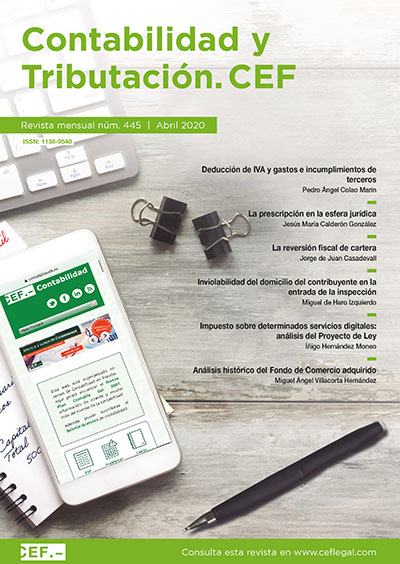Análisis histórico del fondo de comercio adquirido
DOI:
https://doi.org/10.51302/rcyt.2020.3625Palabras clave:
fondo de comercio, amortización, deterioro de valor, activo intangibleResumen
El objetivo de este artículo es revisar la historia de la contabilización del fondo de comercio adquirido en el Reino Unido, Estados Unidos, Francia y España, para identificar si existe un patrón o una tendencia de estos cambios.
La conclusión es que el criterio de contabilización ha variado de forma asimétrica en los diferentes países, sin que pueda observarse una relación entre la variación en el paradigma y la explicación de estos cambios. El único hecho que ha modificado el tratamiento de forma generalizada es la adopción de las normas del IASB por parte de los países de la Unión Europea.
Descargas
Citas
Accounting Standards Board (ASB). (1997). Financial Reporting Standard No. 10 Goodwill and Intangible Assets. London: The Accounting Standards Board Limited, December 1997. Recuperado de https://frc.org.uk/getattachment/8c379f9e-168a-4d5a-9711-be9faafa1f32/FRS-10-Goodwilland-Intangible-Assets-Dec-1997.pdf
American Institute of Accountants. (1917). Uniform accounting. Journal of Accountancy, 23(6), 401-433.
American Institute of Accountants, Committee on Accounting Procedure. (1944). Accounting for intangible assets. Accounting research bulletin n.º 24. New York: American Institute of Accountants.
American Institute of Accountants, Committee on Accounting Procedure. (1953). Restatement and revision of accounting research bulletins. Accounting research bulletin n.º 43. New York: American Institute of Accountants.
American Institute of Accountants, Committee on Accounting Procedure. (1957). Business combinations, Accounting research bulletin n.º 48. New York: American Institute of Accountants.
American Institute of Certified Public Accountants, Accounting Principles Board. (1967). Reporting the results of operations. Opinions of the accounting principles board no. 9. New York: American Institute of Certified Public Accountants.
American Institute of Certified Public Accountants, Accounting Principles Board. (1970). Intangible assets. Opinions of the accounting principles board no. 17. New York: American Institute of Certified Public Accountants.
Arnold, J.; Egginton, D.; Kirkham, L.; Macve, R. y Peasnell, K. (1992). Goodwill and Other Intangibles. London: Institute of Chartered Accountants in England and Wales.
Brière, M. (1934). Taxation of capital gains and goodwill amortization (PhD Thesis). Faculty of Law, University of Paris, Paris.
Bryer, R. A. (1995). A political economy of SSAP 22: Accounting for goodwill. The British Accounting Review, 27(4), 283-310.
Colasse, B. y Standish, P. (2001). State versus market: Contending interests in the struggle to control French accounting standardisation. En S. McLeay y A. Riccaboni (eds.), Contemporary Issues in Accounting Regulation (pp. 1-40). Boston, MA: Kluwer Academic Publishers.
Cooper, J. (2007). Debating accounting principles and policies: The case of goodwill, 1880–1921. Accounting Business and Financial History, 17(2), 241-264.
Courtis, J. K. (1983). Business goodwill: Conceptual clarification via accounting, legal and etymological perspectives. The Accounting Historians Journal, 10(2), 1-38.
Defliese, P. L. (1971). The APB and its recent and pending opinions. Journal of Accountancy, 131(2), 66-69.
Derruppe, J. (1994). Goodwill. Paris: Dalloz.
Dicksee, L. R. y Stevens, T. M. (1897). Goodwill and Its Treatment in Accounts. London: Gee & Co.
Dicksee, L. R. y Tillyard, F. (1906). Goodwill and Its Treatment in Accounts. (3rd ed.). London: Gee & Co.
Ding, Y.; Richard, J. y Stolowy, H. (2008). Towards and understanding of the phases of goodwill accounting in four Western capitalist countries: From stakeholder model to shareholder model. Accounting, Organizations and Society, 33(7), 718-755.
Financial Accounting Standards Board (FASB). (2000). Using cash flow information and present value in accounting measurements. Statement of financial accounting concepts n.º 7. Norwalk, CT: FASB.
Financial Accounting Standards Board (FASB). (2001a). Business combinations. Statement of financial accounting standards n.º 141. Norwalk, CT: FASB.
Financial Accounting Standards Board (FASB). (2001b). Goodwill and other intangible assets. Statement of financial accounting standards n.º 142. Norwalk, CT: FASB.
Financial Reporting Council (FRC). (2015). FRS 102 The Financial Reporting Standard applicable in the UK and Republic of Ireland. Recuperado de https://frc.org.uk/getattachment/e1d6b167-6cdb-4550-bde3-f94484226fbd/FRS-102-WEB-Ready-2015.pdf
Garcia, C. (2013). Goodwill’s useful life in accounting literature: A review article based on theories of value. En Proceedings of the 72th congress of the Japanese accounting research association. Nagoya, September 4-6.
Garcia, C.; Katsuo, Y.; Mourik, C. (2018). Goodwill accounting standards in the United Kingdom, the United States, France, and Japan. Accounting History, 00(0), 1-24.
Grinyer, J. R.; Russell, A. y Walker, M. (1990). The rationale for accounting for goodwill. The British Accounting Review, 22(3), 223-235.
Hatfield, H. R. (1913). Modern Accounting: Its Principles and Some of Its Problems. New York: D. Appleton & Company.
Higson, C. (1998). Goodwill. The British Accounting Review, 30(2), 141-158.
Hughes, H. P. (1982). Goodwill in Accounting: A History of the Issues and Problems. Atlanta, GA: Business Publishing Division, Georgia State University.
Leake, P. D. (1914). Goodwill: Its Nature and How to Value It. London: Gee & Co.
Lee, T. A. (1971). An example of will-o’-the-wisp accounting. Accounting and Business Research, 1(4), 318-328.
Lee, T. A. (1973). Accounting for goodwill: An empirical study of company practices in the United Kingdom -1962 to 1971. Accounting and Business Research, 3(11), 175-196.
Ma, R. y Hopkins, R. (1988). Goodwill – An example of puzzle-solving in accounting. Abacus, 24(1), 75-85.
Mikol, A. (1995). The history of financial reporting in France. En P. J. Walton (ed.), European financial reporting: A history (pp. 91-122). London: Academic Press.
Montgomery, R. H. (1913). Auditing: Theory and Practice. New York: Ronald Press Company.
Napier, C. (1995). The history of financial reporting in the UK. En P. H. Walton (ed.), European financial reporting: A history (pp. 259-283). London: Academic Press.
Nobes, C. W. (1992). A political history of goodwill in the UK: An illustration of cyclical standard setting. Abacus, 28(2), 142-167.
Richard. J. (1996). Comptabilités et pratiques comptables. Paris: Dalloz.
Richard, J. (2001). History of value in the French and German accounting regulation from 1673 to 1914. En J. F. Casta y B. Colasse (eds.), Juste valeur, enjeux techniques et politiques (pp. 17-45). Paris: Economica.
Sanders, T. H.; Hatfield, H. R. y Moore, U. (1938). A Statement of Accounting Principles. New York: American Institute of Accountants.
Turot, J. (1996). Intangibles are no more eternal. Droit Fiscal, 5, 168-171.
















